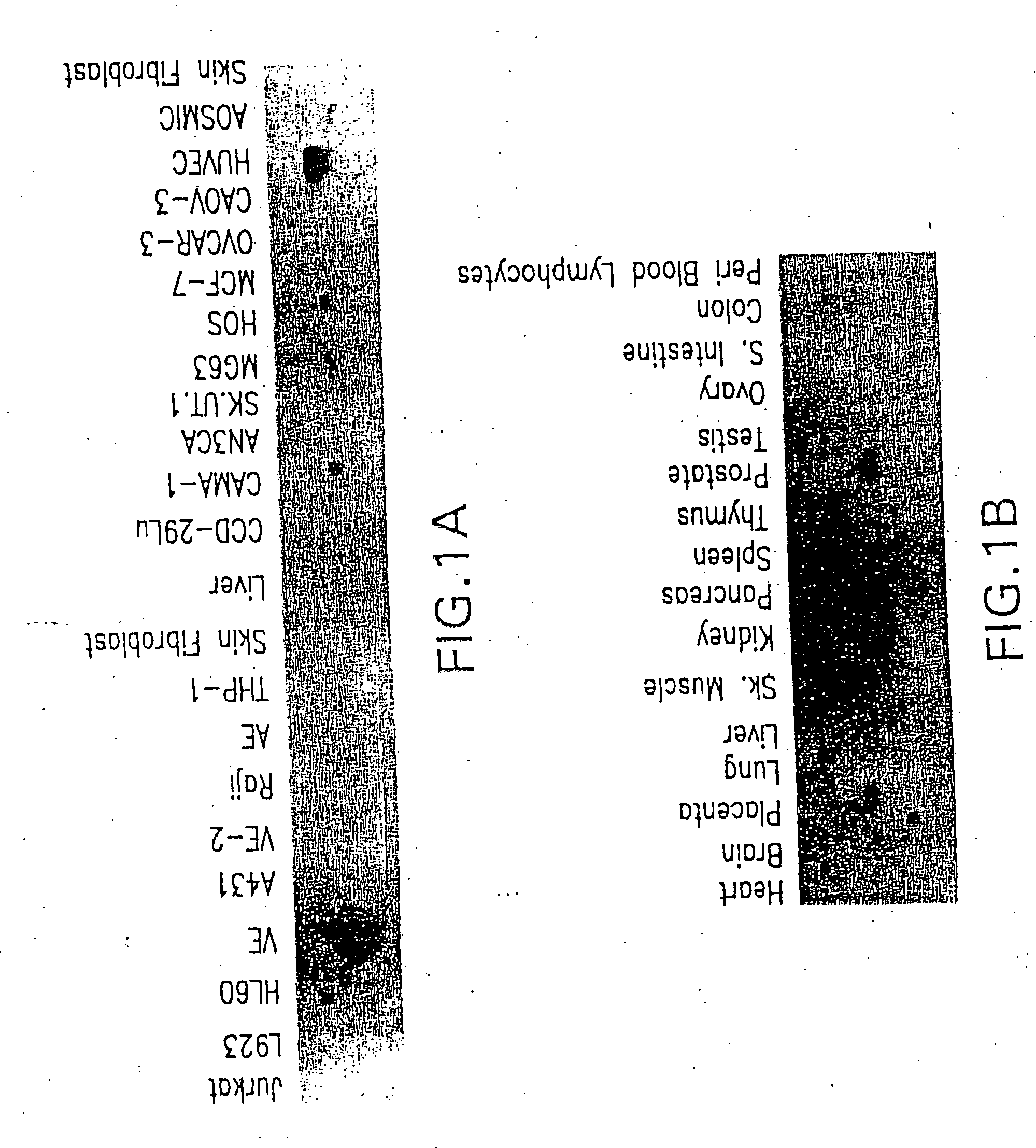VEGI, an inhibitor of angiogenesis and tumor growth
a tumor growth and angiogenesis technology, applied in the field of vegi, can solve the problems of difficult stopping and prolonging of pathological angiogenesis, and achieve the effect of upregulating angiogenesis and promoting angiogenesis
- Summary
- Abstract
- Description
- Claims
- Application Information
AI Technical Summary
Benefits of technology
Problems solved by technology
Method used
Image
Examples
example 1
Bacterial Expression and Purification of VEGI Polypeptides
[0338] An expression vector containing a polynucleotide insert which encodes a 38 amino acid deletion from the N-terminal sequence of the predicted full length VEGI-alpha polypeptide was constructed. The DNA sequence encoding the N-terminally deleted VEGI-alpha polynucleotide was amplified using PCR oligonucleotide primers specific to the coding sequence of the VEGI-alpha coding sequence. Additional nucleotides generating restriction sites to facilitate cloning were added to the 5′ and 3′ sequences, respectively. The 5′ oligonucleotide primers had the 5′-GCG CCA TGG CTC TGC ACT GGG AAC AT-3′ (SEQ ID NO:3) containing a Nco I restriction site, followed by 18 nucleotides of coding sequence. The 3′ primer has the sequence 5′-CGC AAG CTT CTA TAG TAA GAA GGC TCC-3′ (SEQ ID NO:4) contains a Hin dIII restriction site followed by 18 nucleotides complementary to the last 15 nucleotides of the coding sequence and the stop codon. The am...
example 2
Cloning and Expression of VEGI Polypeptides Using the Baculovirus Expression System
[0341] The DNA sequence encoding the full length VEGI-alpha polypeptide, ATCC No. 75927, was amplified using PCR oligonucleotide primers corresponding to the 5′ and 3′ sequences of the gene: The 5′ primer has the sequence 5′-GCG CGG ATC CAC CAT GAG ACG CTT TTT AAG CAA AGT C-3′ (SEQ ID NO:15) and contains a Bam HI restriction enzyme site (in bold) followed by 24 nucleotides of the VEGI-alpha coding sequence (the initiation codon for translation “ATG” is underlined). The 3′ primer has the sequence 5′-CGC GTC TAG ACT ATA GTA AGA AGG CTC CAA AGA AGG-3′ (SEQ ID NO:16) and contains the cleavage site for the restriction endonuclease Xba I and 22 nucleotides complementary to the 3′ non-translated sequence of the VEGI-alpha coding sequence. The amplified sequences were isolated from a 1% agarose gel using a commercially available kit (“Geneclean,” BIO 101 Inc., La Jolla, Calif.). The fragment was then digeste...
example 3
Expression of Recombinant VEGI-Alpha in Mammalian Cells
[0350] The chinese hamster ovary (CHO) dihydrofolate reductase-negative (DHFR−) cell line was purchased from the American Type Culture Collection. Cloning of the VEGI-alpha cDNA into the pCl Chinese Hamster Ovarian Cell expression vector was carried out essentially as follows. The human cDNA sequence encoding the full length VEGI-alpha polypeptide was amplified using primers specific to the 5- and 3′ -end of the VEGI-alpha coding sequence (5-Primer: GCG gga tcc GCC ACC ATG AAC TCC TTC TCC ACA AGC GCC TTC GGT CCA GTT GCC TTC TCC CTG GGG CTG CTC CTG GTG TTG CCT GCT GCC TTC CCT GCC CCA GTT GTG AGA C (SEQ ID NO:5), containing a Bam HI restriction site followed by a “Kozak” sequence (lowercase letters above) and the first 84 bases of the IL6 coding sequence and 13 bases of the VEGI-alpha coding sequence; 3′-primer: CGC gga tcc GAT ATT TGC TCT CCT CCT CA (SEQ ID NO:6), containing a Bam HI restriction site) followed by 17 nucleotides ...
PUM
| Property | Measurement | Unit |
|---|---|---|
| Inhibition | aaaaa | aaaaa |
Abstract
Description
Claims
Application Information
 Login to View More
Login to View More - R&D
- Intellectual Property
- Life Sciences
- Materials
- Tech Scout
- Unparalleled Data Quality
- Higher Quality Content
- 60% Fewer Hallucinations
Browse by: Latest US Patents, China's latest patents, Technical Efficacy Thesaurus, Application Domain, Technology Topic, Popular Technical Reports.
© 2025 PatSnap. All rights reserved.Legal|Privacy policy|Modern Slavery Act Transparency Statement|Sitemap|About US| Contact US: help@patsnap.com



